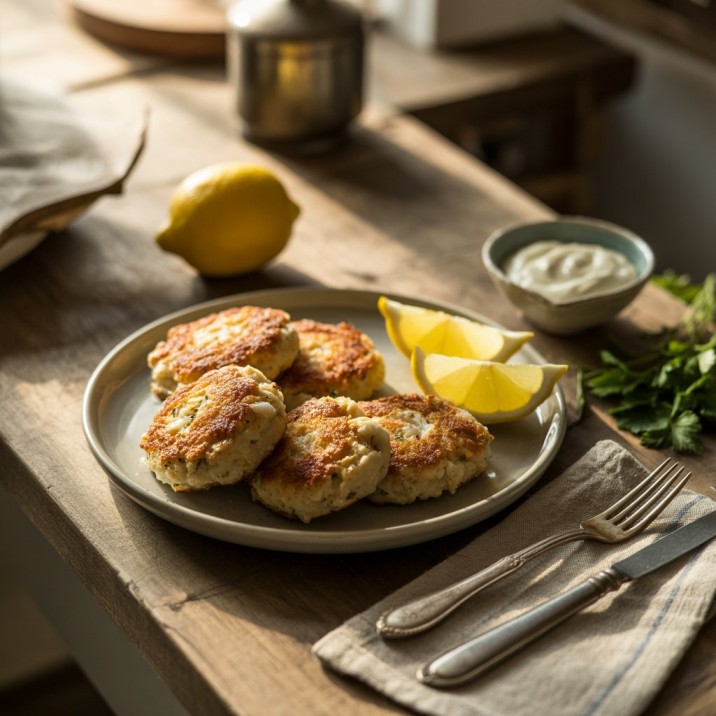Have you ever dreamed of biting into a golden-brown, crispy crab cake that’s bursting with tender, sweet crab meat and just the right amount of seasoning? For many food lovers, the humble crab cake is a true delicacy, a taste of coastal comfort that transports you straight to the seaside. While they might seem fancy, I’m here to tell you that making your own delicious crab cakes at home is not only possible but incredibly rewarding. Forget those store-bought versions that are more filler than crab; today, I’m going to walk you through my favorite crab cakes recipe, sharing all the secrets to creating a masterpiece that will impress everyone at your table. Let’s dive into a fun recipe full of bold flavors that everyone will love.
Table of Contents
Key Takeaways
- Quality Crab is Key: Great crab cakes start with great crab—use fresh lump or jumbo lump meat and make sure it’s free of shells.
- Gentle Mixing Matters: Mix the ingredients gently so the crab stays chunky and your cakes stay soft, not mushy.
- Balance of Flavor: A good binder enhances, not overwhelms, the natural sweetness of the crab. You only need a little to make the crab cakes firm—extra isn’t necessary.
- Versatile Cooking: You can pan-fry for a crispy crust or bake for a lighter option, both yielding delicious results for your homemade crab cakes.
- Don’t Overcook: Crab meat cooks quickly. Overcooking will dry it out and diminish its delicate flavor and texture.
Why Make Homemade Crab Cakes?
There’s something uniquely satisfying about preparing a beloved dish from scratch, and crab cakes recipe is no exception. When you make them yourself, you control every single ingredient, ensuring freshness, quality, and flavor that simply can’t be matched by pre-made options.
- Freshness You Can Taste: You choose the best crab meat, ensuring a sweet, ocean-fresh flavor.
- No Mystery Fillers: Many commercial crab cakes are packed with breadcrumbs or other fillers. Your homemade version will be rich in crab!
- Customizable Flavors: Want a little more spice? Less salt? You decide! This crab cake recipe can easily be adjusted to match your favorite flavors.
- A Rewarding Experience: The joy of seeing your friends and family enjoy a dish you’ve lovingly prepared is truly priceless.
A Quick Guide to Picking the Right Crab Meat for Your Recipe
This is arguably the most important step in any crab cakes recipe. The type of crab meat you choose will directly impact the texture and flavor of your finished product.
- Jumbo Lump: Jumbo lump crab meat is taken from the swimming fins and is known for its large, white pieces and mild sweetness. It’s perfect for when you want your crab cakes to feel a little fancy.
- Lump: Lump crab offers a nice balance of size and flavor, with a mix of large flakes. They offer excellent flavor and texture and are a fantastic choice for a high-quality crab cake.
- Backfin: Backfin offers a mix of tender body meat and some chunkier pieces for texture. It’s a good all-around choice, offering a good balance of flavor and affordability.
- Claw: This part of the crab offers a stronger, saltier flavor and darker meat. While delicious in soups or stews, it’s generally not recommended as the primary crab meat for classic crab cakes due to its stronger taste and shreddier texture.
For the best results with your crab cakes recipe, I always recommend using lump or jumbo lump crab meat. You’ll usually find pasteurized crab meat in the fridge section—be sure to pick through it for any bits of shell.
“Great crab cakes start with top-quality crab meat, not just a good recipe.”
Must-Have Ingredients for Making Amazing Crab Cakes

Along with the crab, a few simple ingredients help hold everything together and bring out its sweet flavor. Let’s go over what you’ll need for this easy and tasty crab cakes recipe:
- 1 pound of good lump or jumbo lump crab meat, with any shells removed.
- 1/2 cup mayonnaise: Full-fat is best for richness and binding.
- 1 large egg: gently whisked—it helps hold the crab mixture together.
- 1 tablespoon Dijon mustard—it adds a nice zing to the mix.
- 1 tablespoon Worcestershire sauce: A savory kick that complements seafood beautifully.
- 1 teaspoon Old Bay seasoning: This is the go-to spice for crab cakes! No Old Bay? Mix paprika, celery salt, pepper, and a pinch of cayenne.
- A handful (about 1/4 cup) of fresh parsley adds a fresh, green touch.
- Use 1/2 cup of panko for a lighter texture, or regular breadcrumbs if that’s what you have.
- Taste and season with a pinch of salt and fresh pepper as needed.
- Choose either butter or olive oil (2 tablespoons) depending on your taste and cooking style.
- Lemon wedges: For serving.
Step-by-Step Guide to Making Your Crab Cakes Recipe
Now for the fun part! Follow these steps carefully, and you’ll be enjoying incredible homemade crab cakes in no time.
1. Prep the Crab Meat
First things first, gently pick through your crab meat. Even if it’s labeled “picked,” there’s always a chance of a tiny shell fragment hiding. Add the crab meat to a mixing bowl, gently so you don’t break up the large pieces. We want those beautiful pieces to shine! ✨
2. Make the Binder
Whisk the mayo, egg, mustard, Worcestershire, parsley, and seasonings in a separate bowl until well blended. This mixture is the flavor base that will hold your crab cakes together and infuse them with deliciousness.
3. Gently Combine
Pour the mayonnaise mixture over the crab meat. Now, this is crucial: Gently fold the ingredients together using a rubber spatula or your hands. You want to mix everything gently so the crab meat gets coated without falling apart. Overmixing will result in mushy crab cakes, and we definitely don’t want that! Add the breadcrumbs and carefully stir until everything holds together. The breadcrumbs absorb excess moisture and help bind the cakes.
4. Form the Cakes
After everything is mixed, go ahead and start forming the crab cakes. Scoop out about 1/3 to 1/2 cup of the mixture for each cake, depending on your desired size. Use your hands to form patties that are roughly 1 inch thick. Make sure all the cakes are about the same size so they cook at the same rate. This crab cakes recipe typically yields 6-8 medium-sized cakes. Place the formed cakes on a plate or baking sheet lined with parchment paper.
“Patience in mixing and gentle handling are the secrets to perfectly textured crab cakes.”
5. Chill for Firmness (Optional, but Recommended)
For best results, cover the crab cakes and refrigerate them for at least 30 minutes. Letting them rest in the fridge makes them less likely to break apart in the pan. If you’re short on time, you can skip this step, but chilling does make a difference!
6. Cook Your Crab Cakes
You have a couple of excellent options for cooking your crab cakes:
Option A: If you love a golden crust, try pan-frying!
- Warm a tablespoon of butter or oil in a non-stick pan on medium heat. Avoid putting too many in the pan at once; cook in rounds if necessary.
- Once the butter is melted and shimmering (or oil is hot), carefully place the crab cakes into the skillet. Don’t overcrowd the pan; leave some space between each cake.
- Let each side cook for 4-5 minutes, or until the outside is golden and crunchy. Make sure the inside hits 165°F to be fully cooked.
- Remove from the pan and place on a plate lined with paper towels to drain any excess oil.
Option B: Baking (A Lighter Alternative)
- Preheat your oven to 400°F (200°C).
- Use parchment or a light layer of oil to prep your baking sheet.
- Arrange the crab cakes on the tray you just prepped.
- Bake for about 15-20 minutes, flipping once, until they’re golden and hot inside. Don’t forget—cook until the inside hits 165°F again.
Tips for Success with Your Crab Cakes Recipe
- Don’t Overmix: I can’t stress this enough! Overmixing breaks down the delicate crab meat, turning your lovely lumps into a paste. Use a light hand.
- Taste the Binder: Try your mayo mixture before adding the crab so you can adjust the flavor. Remember, the crab itself is sweet, so the binder should complement it.
- Don’t Skimp on Quality: This isn’t the time to go for the cheapest crab meat. Good crab makes a big difference in flavor, so go for the best you can get.
- Panko for Texture: Panko adds a nice crunch and a light feel compared to regular breadcrumbs. If you only have regular, that’s fine, but panko is preferred.
- Even Cooking: You want the pan hot enough for a good sear, but not smoking. If baking, ensure your oven is fully preheated.
Serving Suggestions

Your beautiful homemade crab cakes deserve to be served with pride! Here are some ideas:
- Classic Lemon Wedges: A squeeze of fresh lemon juice is essential. It brightens the flavor and cuts through the richness. 🍋
- Tartar Sauce: A timeless pairing! Make tartar sauce at home with mayo, pickles, capers, and dill—or grab one from the store.
- Remoulade Sauce: A spicier, more complex sauce than tartar, often made with mayonnaise, mustard, Cajun seasoning, and various herbs.
- Fresh Green Salad: A simple side salad with a light vinaigrette provides a refreshing contrast.
- Coleslaw: Creamy coleslaw is another classic side that works wonderfully.
- Roasted Asparagus or Green Beans: Simple, healthy, and delicious.
Serve your crab cakes as an appetizer, a light lunch, or as part of a more elaborate dinner. They’re incredibly versatile!
Looking for More delicious recipes?
check out some of our other top recipes:
Kosher for Pesach Sushi Recipe
High Protein Pureed Food Recipes
Storing Leftovers
If you happen to have any leftover crab cakes (a rare occurrence in my house!), you can store them in an airtight container in the refrigerator for upgto 2-3 days. To reheat, you can gently warm them in a skillet over medium-low heat until heated through, or in a preheated oven at 350°F (175°C) for about 10-15 minutes. Skip the microwave—reheating that way can make them tough.
Conclusion
There you have it – my comprehensive guide to making the most exquisite homemade crab cakes. This crab cakes recipe is more than just a list of ingredients; it’s a labor of love that results in a truly memorable dish. The sweet, delicate crab meat, enhanced by a perfectly balanced binder and a crispy exterior, is a culinary experience that’s hard to beat. I truly believe that once you try making them yourself, you’ll never go back to store-bought. So, gather your ingredients, follow these steps, and get ready to impress yourself and your loved ones with the best crab cakes you’ve ever tasted. Happy cooking!

Best Homemade Crab Cakes Recipe – Easy & Delicious!
Description
Learn my ultimate crab cakes recipe! Make perfectly golden, flavorful crab cakes at home with fresh crab meat and simple steps. Impress your guests!
Ingredients:
Instructions
-
1. Prep the Crab Meat
-
First things first, gently pick through your crab meat. Even if it's labeled "picked," there's always a chance of a tiny shell fragment hiding. Add the crab meat to a mixing bowl, gently so you don’t break up the large pieces. We want those beautiful pieces to shine! ✨
-
2. Make the Binder
-
Whisk the mayo, egg, mustard, Worcestershire, parsley, and seasonings in a separate bowl until well blended. This mixture is the flavor base that will hold your crab cakes together and infuse them with deliciousness.
-
3. Gently Combine
-
Pour the mayonnaise mixture over the crab meat. Now, this is crucial: Gently fold the ingredients together using a rubber spatula or your hands. You want to mix everything gently so the crab meat gets coated without falling apart. Overmixing will result in mushy crab cakes, and we definitely don't want that! Add the breadcrumbs and carefully stir until everything holds together. The breadcrumbs absorb excess moisture and help bind the cakes.
-
4. Form the Cakes
-
After everything is mixed, go ahead and start forming the crab cakes. Scoop out about 1/3 to 1/2 cup of the mixture for each cake, depending on your desired size. Use your hands to form patties that are roughly 1 inch thick. Make sure all the cakes are about the same size so they cook at the same rate. This crab cakes recipe typically yields 6-8 medium-sized cakes. Place the formed cakes on a plate or baking sheet lined with parchment paper.
-
"Patience in mixing and gentle handling are the secrets to perfectly textured crab cakes."
-
5. Chill for Firmness (Optional, but Recommended)
-
For best results, cover the crab cakes and refrigerate them for at least 30 minutes. Letting them rest in the fridge makes them less likely to break apart in the pan. If you're short on time, you can skip this step, but chilling does make a difference!
-
6. Cook Your Crab Cakes
-
You have a couple of excellent options for cooking your crab cakes:
-
Option A: If you love a golden crust, try pan-frying!
-
Warm a tablespoon of butter or oil in a non-stick pan on medium heat. Avoid putting too many in the pan at once; cook in rounds if necessary.
-
Once the butter is melted and shimmering (or oil is hot), carefully place the crab cakes into the skillet. Don't overcrowd the pan; leave some space between each cake.
-
Let each side cook for 4-5 minutes, or until the outside is golden and crunchy. Make sure the inside hits 165°F to be fully cooked.
-
Remove from the pan and place on a plate lined with paper towels to drain any excess oil.
-
Option B: Baking (A Lighter Alternative)
-
Preheat your oven to 400°F (200°C).
-
Use parchment or a light layer of oil to prep your baking sheet.
-
Arrange the crab cakes on the tray you just prepped.
-
Bake for about 15-20 minutes, flipping once, until they’re golden and hot inside. Don’t forget—cook until the inside hits 165°F again.
Nutrition Facts
Servings 8
- Amount Per Serving
- Calories 210kcal
- % Daily Value *
- Total Fat 12g19%
- Saturated Fat 3g15%
- Cholesterol 90mg30%
- Sodium 400mg17%
- Protein 14g29%
* Percent Daily Values are based on a 2,000 calorie diet. Your daily value may be higher or lower depending on your calorie needs.
Note
Protein is high thanks to the crab meat and egg.
Fat comes mainly from mayonnaise and butter/oil used for cooking.
Carbs mostly from panko breadcrumbs.
Sodium varies with Old Bay seasoning and Worcestershire sauce.



